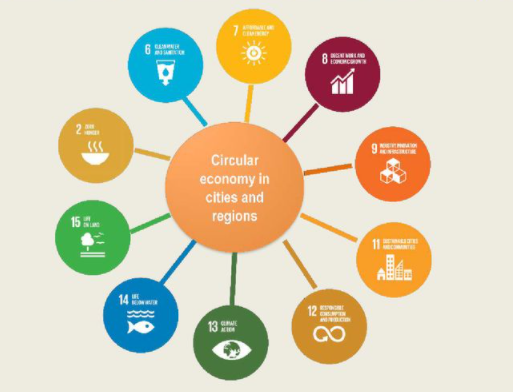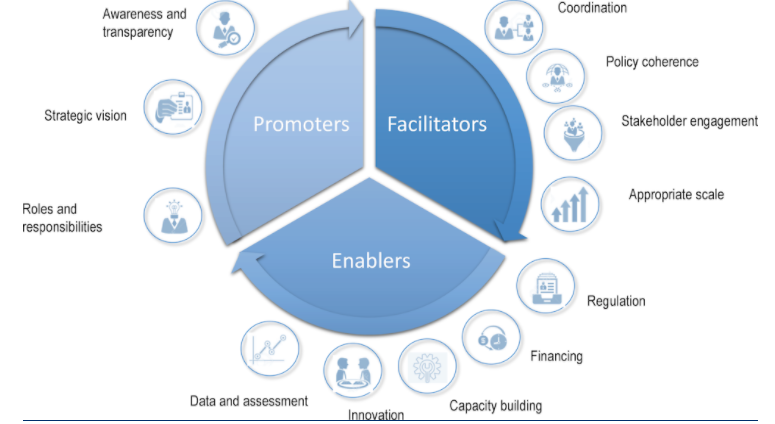DOI : 10.48256/TDM2012_00154
The Solution to Environmental Degradation
Climate change is hindering economic growth and challenging national governments all over the globe. This year, the Earth Overshoot day fell on August 22 (Earth Overshoot Day, 2020). “Earth Overshoot Day marks the date when humanity’s demand for ecological resources and services in a given year exceeds what Earth can regenerate in that year” (Earth Overshoot Day, 2020). This means that time is running out, that there is no Planet B, that societies are consuming more than what nature can offer. Consumers’ demands are likely to increase by 2050, and therefore current economic models will have to undergo profound change and endorse full sustainable practices if they want to survive. The Circular Economy Action Plan launched this year by the European Commission has highlighted the need to move away from linear economic models in order to embrace the green revolution and mitigate climate change.
In a post-COVID-19 scenario, the circular economy will play a crucial role in guaranteeing recovery and compliance with environmental standards. “This unprecedented crisis highlighted the unsustainable nature of certain environmental and social trends and led to a reconsideration of current production and consumption patterns, including for mobility, material use and food” (OECD, 2020). The 2030 Agenda for Sustainable Development stresses the need to endorse fully sustainable practices, from the production phase and throughout the entire value chain. The transition to a circularity will contribute to the acceleration of green policies and programs to meet the Sustainable Development Goals. “The circular economy can help address unsustainable trends and find adequate solutions towards a green recovery; cities and regions have a role to play in closing the loops, reducing waste, reusing resources and restoring ecosystems alongside long-term recovery measures for more resilient, sustainable and thriving societies” (OECD, 2020).
What is the Circular Economy? When Waste Becomes a Resource
According to the definition provided by the Ellen MacArthur Foundation, the circular economy consists of “designing out waste and pollution, keeping products and materials in use, and regenerating natural systems” (Ellen MacArthur Foundation, 2017). More specifically, circularity consists of five major pillars, from sustainable resources to digitalization and life extension capabilities (Enel, 2020). A circular economic model will encompass a regenerative system, “bringing together economic development, environmental sustainability and social inclusion” (Enel, 2020).
In the aftermath of the pandemic, the transition to a circular economy will foster economic recovery, environmental safeguard and social well-being. “A circular economy provides the opportunity to rethink how we make and use the things we need and allows us to explore new ways of ensuring long-term prosperity” (Ellen MacArthur Foundation, 2019). In other words, the circular economy envisages a holistic approach in order to have a regenerative system that creates new business models, boosts innovation and research, favors economic growth and establishes safeguards for the environment.
Cities at the Epicenter of Circular Activities
“As major engines for economic growth, cities can drive the circular economy agenda forward to unlock economic, environmental, and social benefits” (Ellen MacArthur Foundation, 2019). The latest report of the OECD on sustainable cities and regions asserts that by 2050 world population will reach 9 billion people, with roughly more than half living in cities. “Cities represent two thirds of global energy demand, produce up to 50% of solid waste and are responsible for 70% of greenhouse emissions” (OECD, 2020). Thus, it is of uttermost importance for cities to become active players in the transition to the circular economy, engaging in all circular activities. In fact, urban centers can act as tripartite players: promoting the circular economy, facilitating connections between different actors and enabling appropriate governance conditions (OECD, 2020).
Circular Promoters and Facilitators
Cities can promote circular economy approaches by establishing roles and responsibilities, endorsing a strategic vision and raising awareness and transparency (OECD, 2020). City governments can encourage the active participation of all stakeholders in the implementation of circular activities and adoption of circular strategies. In fact, sustainable production and consumption practices would favor the transition to a holistic circular system, in which both producers and consumers are aware of circular best practices and incentivize a more circular behavior (OECD, 2020). By raising awareness on the environmental consequences of both producers and consumers’ actions, cities can enhance a responsible and circular approach.
In addition to the promotion of circular practices, cities play a significant role as facilitators by “implementing effective multi-level governance coordination, enhancing policy coherence and systemic thinking, fostering stakeholder engagement, and adopting a functional approach to identify the appropriate scale for action” (OECD, 2020). By stimulating active collaboration and multi-level governance, cities can augment coordinated action devoted to the transition from a linear to a fully circular model, contributing to the deployment of circular projects (OECD, 2020).
Circular Enablers
Moreover, “cities can act as enablers of the transition, providing the conditions for the circular economy to happen in practice. To this end, cities can adapt and update regulatory instruments to foster the transition to the circular economy, mobilize and efficiently allocate financial resources for circular economy initiatives, develop training programs to foster human and technical capacities, support business innovation, and generate an information system and assess impacts of policies and strategies” (OECD, 2020). For instance, regulation addressing the need for circular criteria would enable the transition and foster circular practices, as well as legislative initiatives discouraging irresponsible behavior through taxonomy regulation (OECD, 2020). Rethinking legislation in order to adapt it to the circular economy might accelerate the process towards regulations that entail circular targets.
Thus, the implementation of new regulation on circular practices could render the transition to a circular approach attractive and convenient, both for businesses and consumers. Urban areas could also facilitate the access to financial instruments for companies that will adhere to best circular practices, or guarantee financial benefits (for example, reduced value added tax on products with circular labels) to encourage a more circular approach (OECD, 2020). The implementation of circular activities, from waste management to infrastructure and design can mitigate the negative environmental impact of business activities and promote a sustainable behavior aimed at rendering city activities fully circular. “Cities hold core competencies for most policy areas underlying the circular economy, including water, solid waste, build environment, land use or climate change” (OECD, 2020).
Thriving, Liveable and Resilient
As the Ellen MacArthur Foundation (2019) illustrates, the circular economy can contribute to the development of:
- “Thriving cities, in which economic productivity increases through reduced congestion, eliminated waste, and reduced costs, and where new growth and business opportunities can support skills development and jobs;
- Liveable cities with improved air quality and urban health, reduced carbon emissions and pollution, and with enhanced social interactions;
- Resilient cities, keeping materials in use and reducing virgin material pressures, working with both local and distributed production capacity, and harnessing digital technology”.
Final Remarks
Global challenges require global efforts. The pandemic has demonstrated that the international community should change its modus operandi and implement circular practices in order to limit environmental degradation and economic stagnation. “By reconfiguring material loops, the circular economy offers an example of resilience in the face of future crises: human-centered cities could reduce private car use and regenerate green spaces, organic waste could be transformed into high-quality fertilizer for local food production in rural areas, and buildings, made of traceable and recyclable materials, could absorb carbon dioxide, treat wastewater and produce energy” (OECD, 2020).
Cities will be key drivers in the transition to the circular economy. By 2050, most societies will be concentrated in urban areas, which is why their role is vital to the development of circular business models. “The circular economy provides an opportunity to do more with less, to better use available natural resources, to reduce waste generation in the first place and to transform waste into new resources, while promoting new forms of employment and tackling inequalities” (OECD, 2020).
References
Earth Overshoot Day. (2020). Earth Overshoot Day 2020 Fell on August 22 (online). Available here (Accessed 5 November, 2020).
Ellen MacArthur Foundation. (2017). Circular Economy (online). Available here (Accessed 6 November, 2020).
Ellen MacArthur Foundation. (2019). Circular Economy in Cities – Project Guide (online). Available here (Accessed 6 November, 2020).
Enel. (2020). Circular Cities, Cities of Tomorrow (online). Available here (Accessed November 3, 2020).
OECD. (2020). The Circular Economy in Cities and Regions (online). Available here (Accessed November 4, 2020).
***
Autore dell’articolo*: Eleonora M. Mazza Micara, BA Politics, Philosophy and Economics, MA in International relations presso l’Università LUISS Guido Carli di Roma, e MA in Governance and Global Affairs presso l’Università MGIMO – Moscow State Institute of International Relations di Mosca.
***
Nota della redazione del Think Tank Trinità dei Monti
Come sempre pubblichiamo i nostri lavori per stimolare altre riflessioni, che possano portare ad integrazioni e approfondimenti.
* I contenuti e le valutazioni dell’intervento sono di esclusiva responsabilità dell’autore.
Editor’s Note – Think Tank Trinità dei Monti
As always, we publish our articles to encourage debates, and to spread knowledge and original and alternative points of view.
* The contents and the opinions of this article belong to the author(s) of this article only.



